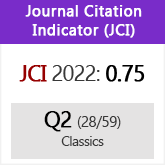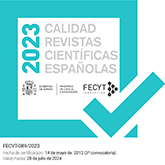Evidentials and Irony in Aeschines and Demosth
DOI:
https://doi.org/10.3989/emerita.2022.04.2202Keywords:
Irony, evidentiality, epistemic modality, legal language, Greek oratoryAbstract
This paper, focused on the three extant speeches of Aeschines ( Against Timarchus, On the Embassy and Against Ctesiphon) and on two speeches of Demosthenes (On the Crown and On the Embassy), analyses the functioning of a selected group of evidentials in ironic statements. The main purpose is to examine the relationship that evidentials may have with the linguistic expression of irony in ancient Greek.
Downloads
References
Aikhenvald, A. (2003): «Evidentiality in Typological Perspective», en Aikhenvald, A. y Dixon, R. (eds.), Studies in Evidentiality, Ámsterdam, pp. 1-31. https://doi.org/10.1075/tsl.54.04aik
Aikhenvald, A. (2004): Evidentiality, Oxford.
Aikhenvald, A. (2018): «Evidentiality: the Framework», en Aikhenvald, A. (ed.), The Oxford Handbook of Evidentiality, Oxford, pp. 1-55. https://doi.org/10.1093/oxfordhb/9780198759515.001.0001
Alcaide, E. R. (2004): «La ironía, recurso argumentativo en el discurso político», RILCE 20 (2), pp. 169-189. https://doi.org/10.15581/008.20.26693
Alvarado Ortega, M.ª B. (2006): «Las marcas de la ironía», Interlingü.stica 16, pp. 1-11.
Alvarado Ortega, M.ª B. & Padilla, X. (2008): «La ironía o cómo enmascarar un acto supuestamente amenazante», en A. Briz et al. (eds.), Cortesía y conversación. De lo escrito a lo oral, Valencia, pp. 419-435.
Austin, J. L. (1962): How to Do Things with Words, Cambridge.
Brown, P. & Levinson, S. C. (1987): Politeness: Some Universals in Language Usage, Cambridge. https://doi.org/10.1017/CBO9780511813085
Burgers, C., van Mulken, M. & Schellens, P. J. (2011): «Finding Irony: An Introduction of the Verbal Irony Procedure (VIP)», Metaphor and Symbol 26 (3), pp. 186-205. https://doi.org/10.1080/10926488.2011.583194
Burgers, C. & Steen, G. J. (2017): «Introducing a Three-Dimensional Model of Verbal Irony», en Athanasiadou, A. y Colston, H. L. (eds.), Irony in Language Use and Communication, Ámsterdam, pp. 87-108. https://doi.org/10.1075/ftl.1.05bur
Chafe, W. & Nichols, J. (eds.) (1986): Evidentiality: the linguistic coding of epistemology, Norwood.
Conti, L. (2018): «Marcadores del discurso y expresiones hechas en griego antiguo: análisis de ἐμοὶ δοκεῖν», Phílos hetaîros. Homenaje al profesor Luis M. Macía, Madrid, pp. 209-217.
Conti, L. (2019): «De la duda a la certeza: sobre el uso de ἴσως en el teatro griego», Incontri Linguistici 42, pp. 111-136.
Cornu, G. (2000): Linguistique Juridique, París.
Coulthard, M., Johnson, A. & Wright, D. (2007): An Introduction to Forensic Linguistics: Language in Evidence, Londres. https://doi.org/10.4324/9780203969717
Cuzzolin, P. (2010): «Evidentialitätsstrategien im Lateinischen: Vorläufige Bemerkungen», en Anreiter, P. y Kienpointner, M. (eds.), Latin Linguistics Today: Akten des 15. internationalen Kolloquiums zur lateinischen Linguistik, Innsbruck, 4.-9. April 2009, pp. 247-256.
Dendale, P. & Tasmowski, L. (2001): «Introduction: Evidentiality and Related Notions», Journal of Pragmatics 33 (3), pp. 339-348. https://doi.org/10.1016/S0378-2166(00)00005-9
Edwards, M. & Spatharas, D. (eds.) (2019): Forensic Narratives in Athenian Courts, Londres. https://doi.org/10.4324/9781315104461
Fornieles, R. (en prensa): «A First Approach to Irony in Greek Oratory» en G. Giannakis et al. (eds.), Historical Linguistics and Classical Philology, Berlín-Boston.
Gibbons, J. (2003): Forensic Linguistics. An Introduction to Language in the Justice System, Oxford.
Goodwin, W. W. (1904): Demosthenes: De Corona, Cambridge.
Haverkate, H. (1985): «La ironía verbal: análisis pragmalingü.stico», Revista Española de Lingüistica 15 (2), pp. 343-391.
Heydon, H. (2019): Researching Forensic Linguistics: Approaches and Applications, Londres. https://doi.org/10.4324/9780429290640
Hollien, H. (2001): Forensic Voice Identification, San Diego.
Hutcheon, L. (1994): Irony's Hedge. The Theory and Politics of Irony, Nueva York.
Jorgensen, J. (1996): «The Functions of Sarcastic Irony in Speech», Journal of Pragmatics 26, pp. 613-634. https://doi.org/10.1016/0378-2166(95)00067-4
Knox, N. (1973): «Irony», en Wiener, P. P. (ed.), Dictionary of the History of Ideas: Studies of Selective Pivotal Ideas, vol. 2, Nueva York.
Kotwica, D. (2015): «Al parecer evidencial atenuante. ¿Y reforzador?», en Álvarez
López, C. J., Garrido Martín, B. y González Sanz, M. (coords.), Jóvenes aportaciones a la investigación lingü.stica, Sevilla, pp. 481-493.
López Eire, A. (1989): Demóstenes. Discursos políticos I, Madrid.
Luarsabishvili, V. (2019): «La ironía: sobre la evolución histórica de la noción», Dicenda 37, pp. 185-198. https://doi.org/10.5209/dice.65000
Lucas de Dios, J. M. (2002): Esquines. Discursos, testimonios y cartas, Madrid.
Marimón-Llorca, C. (2004-2005): «Sobre el sentido irónico en español: aspectos pragmáticos y lexicográficos», Epos 20-21, pp. 33-54 https://doi.org/10.5944/epos.20-21.2004.10464
Martín Zorraquino, M.ª A. & Portolés Lázaro, J. (1999): «Los marcadores del discurso», en Bosque, I. y Demonte, V. (eds.), Gramática Descriptiva de la Lengua Española III: entre la oración y el discurso, Madrid, pp. 4051-4214.
McMenamin, G. R. (1994): Forensic Stylistics: A Workbook, California.
Moussa Sassi, F. Z. (2020): «Manipulative Use of Affect and Evidential Markers in Legal Discourse», Language. Text. Society 7 (1), https://ltsj.online/2020-07-1-moussasassi (09/ 01/ 2022).
Muecke, D. C. (1969): The Compass of Irony, Londres.
Muecke, D. C. (1978): «Irony Markers», Poetics 7, pp. 363-375. https://doi.org/10.1016/0304-422X(78)90011-6
Muñoz Llamosas, V. (2008): «Insultos e invectiva entre Demóstenes y Esquines», Minerva 21, pp. 33-49.
Olsson, J. & Luchjenbroers, J. (2014): Forensic Linguistics, Londres. https://doi.org/10.5040/9781350284845
Palmer, F. (1986): Mood and Modality, Cambridge.
Plungian, V. A. (2001): «The Place of Evidentiality Within the Universal Grammatical Space», Journal of Pragmatics 33 (3), pp. 349-358. https://doi.org/10.1016/S0378-2166(00)00006-0
Plungian, V. A. (2010): «Types of Verbal Evidentiality Marking: An Overview», en Diewald, G. y Smirnova, E. (eds.), Linguistic Realization of Evidentiality in European Languages, Berlín, pp. 15-53.
Rodríguez Ramalle, T. M.ª (2019): «En torno a los valores pragmáticos de la evidencialidad: una nueva aproximación a las relaciones entre evidencialidad e ironía en español», Revista de Investigación Lingü.stica 22, pp. 157-182. https://doi.org/10.6018/ril.384171
Ronnet, G. (1971): Étude sur le style de Démosthène dans les discours politiques, París.
Rose, P. (2002): Forensic Speaker Identification, Londres. https://doi.org/10.1201/9780203166369
Santamaría Pérez, I. (2009): «Los evidenciales», en Ruiz Gurillo, L. y Padilla García, X. A. (eds.), Dime cómo ironizas y te diré quién eres. Una aproximación pragmática a la ironía, Fráncfort del Meno, pp. 267-292.
Schoentjes, P. (2003): La poética de la ironía, Madrid.
Searle, J. R. (1975): «Indirect Speech Acts», en Cole, P. y Morgan, J. L. (eds.), Syntax and Semantics (vol. 3), Nueva York, pp. 59-82. https://doi.org/10.1163/9789004368811_004
Searle, J. R. (1979): Expression and Meaning, Cambridge. https://doi.org/10.1017/CBO9780511609213 PMCid:PMC327709
Shuy, R. W. (1993): Language crimes: The use and abuse of language evidence in the court room, Oxford-Cambridge.
Sommerstein, A. H. (1980): The Comedies of Aristophanes: Acharnians, Warminster.
Torres Sánchez, M.ª A. (1999): Aproximación pragmática a la ironía verbal, Cádiz.
Utsumi, A. (2000): «Verbal Irony as Implicit Display of Ironic Enviroment», Journal of Pragmatics 32, pp. 1777-1806. https://doi.org/10.1016/S0378-2166(99)00116-2
Van Rooy, R. (2016): «The Relevance of Evidentiality for Ancient Greek: Some Explorative Steps through Plato», Journal of Greek Linguistics 16, pp. 3-46. https://doi.org/10.1163/15699846-01502002
Vatri, A. (2018): «Implicit, Explicit and 'Paraphrased' Irony in Attic Oratory», Mnemosyne 71, pp. 1053-1061. https://doi.org/10.1163/1568525X-12342500
Vives Cuesta, A. (2010): «El terreno de la evidencialidad en griego antiguo», en Almela, M.ª A. et al. (eds.), Perfiles de Grecia y Roma: actas del XII Congreso Español de Estudios Clásicos, Madrid, pp. 181-189.
Willet, T. (1988): «A Cross-Linguistic Survey of the Grammaticalization of Evidentiality», Studies in Language 12, pp. 51-97. https://doi.org/10.1075/sl.12.1.04wil
Wilson, D. (2006): «The Pragmatics of Verbal Irony: Echo or Pretence?», Lingua 116, pp. 1722-1746. https://doi.org/10.1016/j.lingua.2006.05.001
Wolsdorf, D. C. (2008): « Eirôneia in Aristophanes and Plato», Classical Quarterly 58, pp. 666-672. https://doi.org/10.1017/S0009838808000724
Yunis, H. (2001): Demosthenes. On the Crown, Cambridge.
Yunis, H. (2005): Demosthenes. Speeches 18 and 19, Austin. https://doi.org/10.7560/705777-007
Downloads
Published
How to Cite
Issue
Section
License
Copyright (c) 2022 Consejo Superior de Investigaciones Científicas (CSIC)

This work is licensed under a Creative Commons Attribution 4.0 International License.
© CSIC. Manuscripts published in both the printed and online versions of this Journal are the property of Consejo Superior de Investigaciones Científicas, and quoting this source is a requirement for any partial or full reproduction.All contents of this electronic edition, except where otherwise noted, are distributed under a “Creative Commons Attribution 4.0 International” (CC BY 4.0) License. You may read here the basic information and the legal text of the license. The indication of the CC BY 4.0 License must be expressly stated in this way when necessary.
Self-archiving in repositories, personal webpages or similar, of any version other than the published by the Editor, is not allowed.
Funding data
Comunidad de Madrid
Grant numbers SI3/PJI/2021-00208
Ministerio de Ciencia, Innovación y Universidades
Grant numbers PGC2018-093779-BI00














